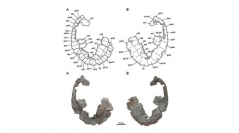

 Comptes Rendus Palevol
14 (6-7) - Pages 563-576
Comptes Rendus Palevol
14 (6-7) - Pages 563-576The long-necked chelid turtle Yaminuechelys aff. maior is described on the basis of post-cranial material of two specimens from the Lower–Middle Campanian Anacleto Formation, nortwestern Patagonia (Argentina). These post-cranial remains are described macroscopically (external morphology) and microscopically (histological sections of the shell). Although minor carapace and plastral differences are reported (e.g., extension of the axillary buttresses on visceral surfaces of the first costal bone, curled bridge peripheral bones, absence of a sub-rectangular fenestra retained in adults) the specimens exibit the shell morphology and surface ornamentation of specimens referred to Y . maior (Staesche, 1929) from Paleocene levels of the Salamanca Formation (Central Patagonia). This assignment is supported by a phylogenetic analysis, in which the new material is the most closely related to Y . maior. As Yaminuechelys is hypothesized to be the sister taxon of Hydromedusa, the capability of Hydromedusa tectifera to adapt to changing environments and the survivorship of Yaminuechelys genus in K/P boundary is discussed.
Pleurodira, Chelidae, Upper cretaceous, Patagonia, South America